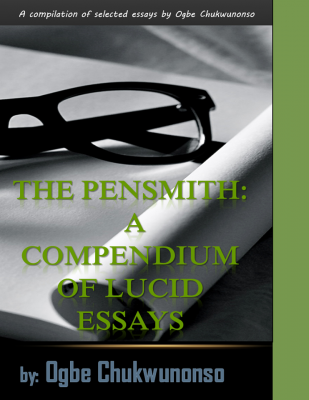Nnaemeka Nwangene reviews Chukwunonso Daniel Ogbe‘s book.
An essay can be defined as a short piece of writing on one particular subject written by a student. It is also a short piece of writing written by a writer for publication.
Essays are generally scholarly pieces of writing giving the author’s own argument, but the definition is vague, overlapping with those of an article, a pamphlet and a short story. Essays can consist of a number of elements, including: literary criticism, political manifestos, learned arguments, observations of daily life, recollections and reflections of the author. Research has shown that almost all modern essays are written in prose form, but works in verse have been dubbed essays.
According to Aldous Huxley, a leading essayist, he notes that the essay is a literary device for saying almost everything about almost anything.
Therefore, an essay can either be short or long, etc. It can also be in prose form or in verse form, but the most important thing here is the fact that essays are written to achieve one or all of the following; to solve a problem, to criticize a problem or to argue for or against a particular problem; a good example for this is the Malthusian essay on population.
The essay on ‘The Pensmith: A Compendium of Lucid Essays‘ by Chukwunonso Daniel Ogbe: Going through this compendium of lucid essays I learnt so much about the world and my country too. “Looking at the mouth of an old man you could see the folly of not eating.” Looking at ‘The Pensmith: A Compendium of Lucid Essays’ I also saw a collection of well researched and well garnered information. The essay in its wholesomeness has been written very well but there are some faults in it, which is the purpose of this essay. They were seen in these forms and include: grammatical errors or typographical errors, the referencing style, the non-inclusion of the reader in the write up or the essay that is in some of the essays, most especially the subchapters.
First is the grammatical error or typographical error as noticed? I saw the use of “save” where I in my opinion felt it should be “except” – this is on “page 103”. In my opinion I feel it should be looked at in terms of double checking or editing the manuscript and the typed work before printing and the publication process begins. I made mention of typographical errors because I feel that mistakes such as this in my opinion could be a typographical error considering the pressure and fatigue being experienced by the typist. But, that notwithstanding it is very necessary that the writer should vet his work properly before printing or publishing the work for the market to behold.
The second issue is the issue of referencing. Going through the references I could not understand how the referencing style came about. This is because the web address was merged with the name of the author, the year of publication, and the location of the publisher or the publishing house (here one would be looking at the state in which the publishing house is located as well as the address of their office.) in some other cases I noticed that in the arrangement of the journal publications, web address links, newspaper review alongside their web links and their dates of publication, volume number, page number etc, were not arranged in either of the American Psychological Association (APA) or in the Modern Language Association (MLA). There were no full stops after the year of publication in most cases and the year of publication should be in brackets and after, there should be a colon and the title of the book in italics although not so compulsory. In the footnotes made I noticed that they were in bigger font sizes and that they were not representing the ideal footnote, instead they were a repetition of the references (Nota Bene: A footnote is a note written at the bottom of a page in a book which provides information about something mentioned on that page),
The third issue is the non-inclusion of the reader in the write up or essay. Here I mean that in some of the subchapters of ‘The Pensmith: A Compendium of Lucid Essays’ I noticed that in some of the essays, there were no definition(s) of the topic or topics being discussed either in the introduction or as a working definition. This enables the reader, who is a layman, to cue in easily from your point of view.
Finally, ‘The Pensmith: A Compendium of Lucid Essays’ is a beautiful, awesome and well garnered collection of information written by the writer for public enlightenment, enrichment and appraisal. Amidst the little loopholes and lapses noticed in the course of reading this book, I still feel highly favored; I still feel the good vibe emanating from the book. I still feel the sense of humor coming from the writer’s ability to use the art of storytelling to ease off the atmosphere of seriousness surrounding the book. I am ever grateful that I came in contact with the book at this time and season.
In conclusion, the art of storytelling is divine and innate in some men and the art of blending the stories that matter with the essays that matter is a gift of grace and that is how impossible it was for me to let go of this book titled ‘The Pensmith: A Compendium of Lucid Essays’. Indeed they were truly lucid. But in other to have a better appraisal emanating from the readers and the writer it is very pertinent we look at some possible solutions which in my opinion include: the use of editors aside from the author which will also go a long way in curbing the issue of errors and incoherent argument in terms of bridging the gap between the message and the messenger (the “message” here being the various ills of the society which the author is keen to address or talk about, while the “messenger” is the reader to whom the information contained in the book is going to be useful, whether good or bad). This is because in Igbo language it is said that “The snake one person saw could be a python.” Another one also says “Two heads are better than one.”
I recommend that for a better appraisal by the average reader the manuscript should be thoroughly scrutinized as to produce a wholesome piece of work for the enrichment, enlightenment etc. for the various readers at home and abroad.
Chukwunonso Daniel Ogbe
Ogbe Chukwunonso Daniel is an alumnus of the University of Nigeria, wherein he was admitted to the degree of Bachelor of Laws in September, 2008 after a successful undergraduate legal career. He was called to the Nigerian Bar on the 3rd day of November 2009 by the Nigerian Body of Benchers and is currently engaged in active legal practice.
In his undergraduate days at the University of Nigeria, Ogbe Chukwunonso Daniel was actively involved in students’ unionism and occupied many leadership positions. The author has to his credit, two other yet to be published books and has won several essay competitions.




No Comments Yet!
You can be first to comment this post!